Muzammil Behzad
Facial Emotion Learning with Text-Guided Multiview Fusion via Vision-Language Model for 3D/4D Facial Expression Recognition
Jul 02, 2025Abstract:Facial expression recognition (FER) in 3D and 4D domains presents a significant challenge in affective computing due to the complexity of spatial and temporal facial dynamics. Its success is crucial for advancing applications in human behavior understanding, healthcare monitoring, and human-computer interaction. In this work, we propose FACET-VLM, a vision-language framework for 3D/4D FER that integrates multiview facial representation learning with semantic guidance from natural language prompts. FACET-VLM introduces three key components: Cross-View Semantic Aggregation (CVSA) for view-consistent fusion, Multiview Text-Guided Fusion (MTGF) for semantically aligned facial emotions, and a multiview consistency loss to enforce structural coherence across views. Our model achieves state-of-the-art accuracy across multiple benchmarks, including BU-3DFE, Bosphorus, BU-4DFE, and BP4D-Spontaneous. We further extend FACET-VLM to 4D micro-expression recognition (MER) on the 4DME dataset, demonstrating strong performance in capturing subtle, short-lived emotional cues. The extensive experimental results confirm the effectiveness and substantial contributions of each individual component within the framework. Overall, FACET-VLM offers a robust, extensible, and high-performing solution for multimodal FER in both posed and spontaneous settings.
Beam-Guided Knowledge Replay for Knowledge-Rich Image Captioning using Vision-Language Model
May 29, 2025Abstract:Generating informative and knowledge-rich image captions remains a challenge for many existing captioning models, which often produce generic descriptions that lack specificity and contextual depth. To address this limitation, we propose KRCapVLM, a knowledge replay-based novel image captioning framework using vision-language model. We incorporate beam search decoding to generate more diverse and coherent captions. We also integrate attention-based modules into the image encoder to enhance feature representation. Finally, we employ training schedulers to improve stability and ensure smoother convergence during training. These proposals accelerate substantial gains in both caption quality and knowledge recognition. Our proposed model demonstrates clear improvements in both the accuracy of knowledge recognition and the overall quality of generated captions. It shows a stronger ability to generalize to previously unseen knowledge concepts, producing more informative and contextually relevant descriptions. These results indicate the effectiveness of our approach in enhancing the model's capacity to generate meaningful, knowledge-grounded captions across a range of scenarios.
Underwater Diffusion Attention Network with Contrastive Language-Image Joint Learning for Underwater Image Enhancement
May 26, 2025Abstract:Underwater images are often affected by complex degradations such as light absorption, scattering, color casts, and artifacts, making enhancement critical for effective object detection, recognition, and scene understanding in aquatic environments. Existing methods, especially diffusion-based approaches, typically rely on synthetic paired datasets due to the scarcity of real underwater references, introducing bias and limiting generalization. Furthermore, fine-tuning these models can degrade learned priors, resulting in unrealistic enhancements due to domain shifts. To address these challenges, we propose UDAN-CLIP, an image-to-image diffusion framework pre-trained on synthetic underwater datasets and enhanced with a customized classifier based on vision-language model, a spatial attention module, and a novel CLIP-Diffusion loss. The classifier preserves natural in-air priors and semantically guides the diffusion process, while the spatial attention module focuses on correcting localized degradations such as haze and low contrast. The proposed CLIP-Diffusion loss further strengthens visual-textual alignment and helps maintain semantic consistency during enhancement. The proposed contributions empower our UDAN-CLIP model to perform more effective underwater image enhancement, producing results that are not only visually compelling but also more realistic and detail-preserving. These improvements are consistently validated through both quantitative metrics and qualitative visual comparisons, demonstrating the model's ability to correct distortions and restore natural appearance in challenging underwater conditions.
Deformable Attentive Visual Enhancement for Referring Segmentation Using Vision-Language Model
May 25, 2025Abstract:Image segmentation is a fundamental task in computer vision, aimed at partitioning an image into semantically meaningful regions. Referring image segmentation extends this task by using natural language expressions to localize specific objects, requiring effective integration of visual and linguistic information. In this work, we propose SegVLM, a vision-language model that incorporates architectural improvements to enhance segmentation accuracy and cross-modal alignment. The model integrates squeeze-and-excitation (SE) blocks for dynamic feature recalibration, deformable convolutions for geometric adaptability, and residual connections for deep feature learning. We also introduce a novel referring-aware fusion (RAF) loss that balances region-level alignment, boundary precision, and class imbalance. Extensive experiments and ablation studies demonstrate that each component contributes to consistent performance improvements. SegVLM also shows strong generalization across diverse datasets and referring expression scenarios.
MOSAIC: A Multi-View 2.5D Organ Slice Selector with Cross-Attentional Reasoning for Anatomically-Aware CT Localization in Medical Organ Segmentation
May 15, 2025Abstract:Efficient and accurate multi-organ segmentation from abdominal CT volumes is a fundamental challenge in medical image analysis. Existing 3D segmentation approaches are computationally and memory intensive, often processing entire volumes that contain many anatomically irrelevant slices. Meanwhile, 2D methods suffer from class imbalance and lack cross-view contextual awareness. To address these limitations, we propose a novel, anatomically-aware slice selector pipeline that reduces input volume prior to segmentation. Our unified framework introduces a vision-language model (VLM) for cross-view organ presence detection using fused tri-slice (2.5D) representations from axial, sagittal, and coronal planes. Our proposed model acts as an "expert" in anatomical localization, reasoning over multi-view representations to selectively retain slices with high structural relevance. This enables spatially consistent filtering across orientations while preserving contextual cues. More importantly, since standard segmentation metrics such as Dice or IoU fail to measure the spatial precision of such slice selection, we introduce a novel metric, Slice Localization Concordance (SLC), which jointly captures anatomical coverage and spatial alignment with organ-centric reference slices. Unlike segmentation-specific metrics, SLC provides a model-agnostic evaluation of localization fidelity. Our model offers substantial improvement gains against several baselines across all organs, demonstrating both accurate and reliable organ-focused slice filtering. These results show that our method enables efficient and spatially consistent organ filtering, thereby significantly reducing downstream segmentation cost while maintaining high anatomical fidelity.
Unsupervised Multiview Contrastive Language-Image Joint Learning with Pseudo-Labeled Prompts Via Vision-Language Model for 3D/4D Facial Expression Recognition
May 14, 2025



Abstract:In this paper, we introduce MultiviewVLM, a vision-language model designed for unsupervised contrastive multiview representation learning of facial emotions from 3D/4D data. Our architecture integrates pseudo-labels derived from generated textual prompts to guide implicit alignment of emotional semantics. To capture shared information across multi-views, we propose a joint embedding space that aligns multiview representations without requiring explicit supervision. We further enhance the discriminability of our model through a novel multiview contrastive learning strategy that leverages stable positive-negative pair sampling. A gradient-friendly loss function is introduced to promote smoother and more stable convergence, and the model is optimized for distributed training to ensure scalability. Extensive experiments demonstrate that MultiviewVLM outperforms existing state-of-the-art methods and can be easily adapted to various real-world applications with minimal modifications.
Contrastive Language-Image Learning with Augmented Textual Prompts for 3D/4D FER Using Vision-Language Model
Apr 28, 2025Abstract:In this paper, we introduce AffectVLM, a vision-language model designed to integrate multiviews for a semantically rich and visually comprehensive understanding of facial emotions from 3D/4D data. To effectively capture visual features, we propose a joint representation learning framework paired with a novel gradient-friendly loss function that accelerates model convergence towards optimal feature representation. Additionally, we introduce augmented textual prompts to enhance the model's linguistic capabilities and employ mixed view augmentation to expand the visual dataset. We also develop a Streamlit app for a real-time interactive inference and enable the model for distributed learning. Extensive experiments validate the superior performance of AffectVLM across multiple benchmarks.
Sparsity-Aware Deep Learning for Automatic 4D Facial Expression Recognition
Feb 08, 2020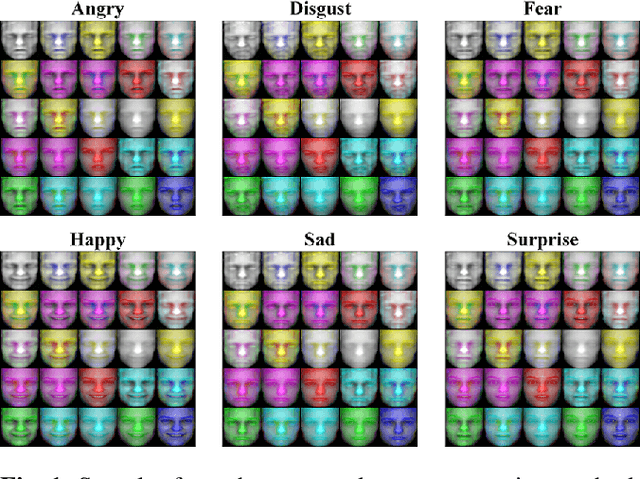
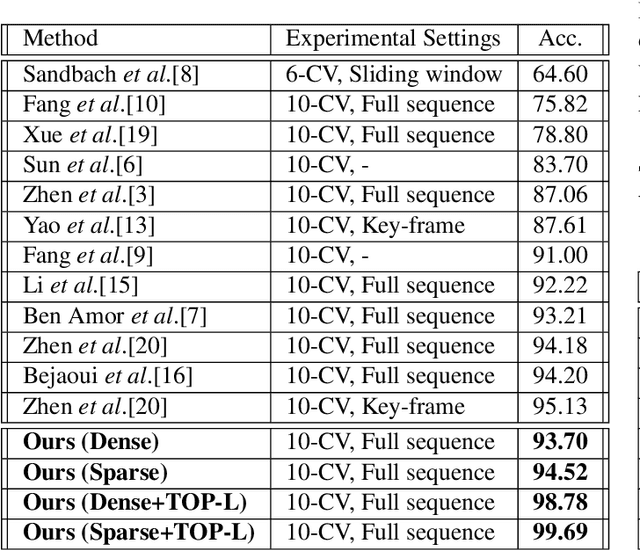

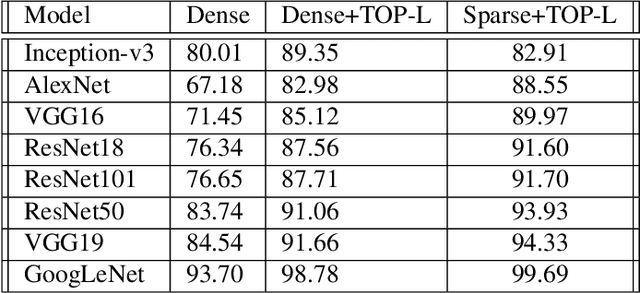
Abstract:In this paper, we present a sparsity-aware deep network for automatic 4D facial expression recognition (FER). Given 4D data, we first propose a novel augmentation method to combat the data limitation problem for deep learning. This is achieved by projecting the input data into RGB and depth map images and then iteratively performing channel concatenation. Encoded in the given 3D landmarks, we also introduce TOP-landmarks over multi-views, an effective way to capture the facial muscle movements from three orthogonal planes. Importantly, we then present a sparsity-aware network to compute the sparse representations of convolutional features over multi-views for a significant and computationally convenient deep learning. For training, the TOP-landmarks and sparse representations are used to train a long short-term memory (LSTM) network. The refined predictions are achieved when the learned features collaborate over multi-views. Extensive experimental results achieved on the BU-4DFE dataset show the significance of our method over the state-of-the-art methods by reaching a promising accuracy of 99.69% for 4D FER.
Landmarks-assisted Collaborative Deep Framework for Automatic 4D Facial Expression Recognition
Oct 11, 2019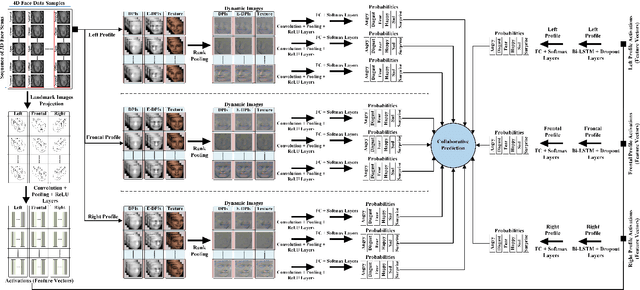
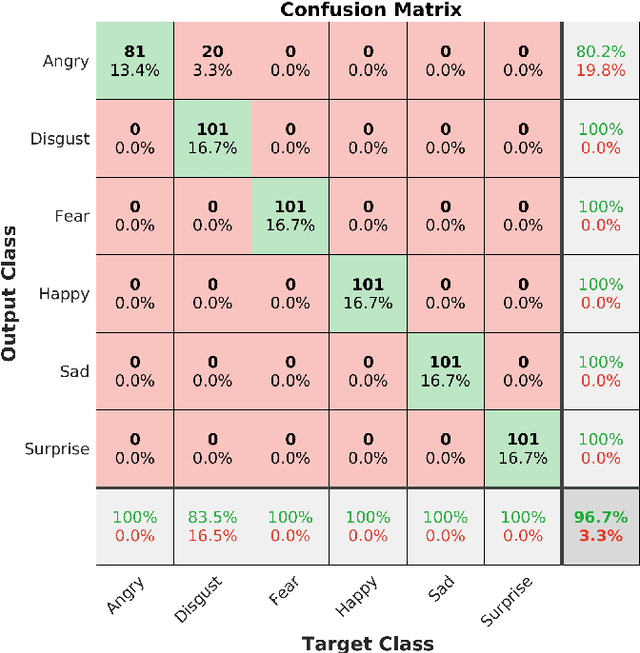
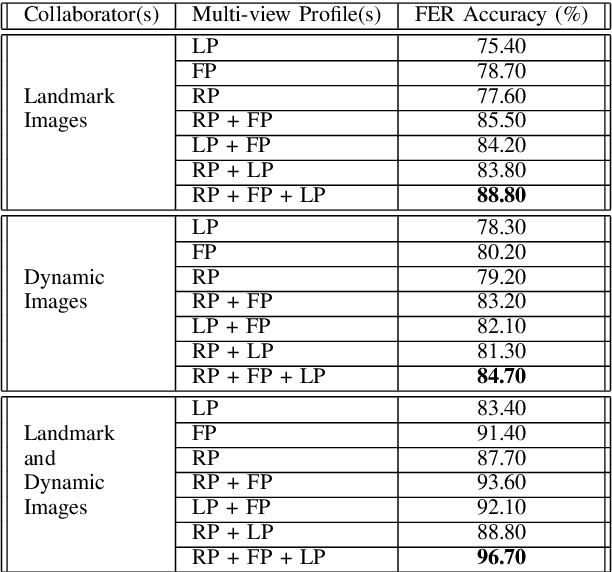
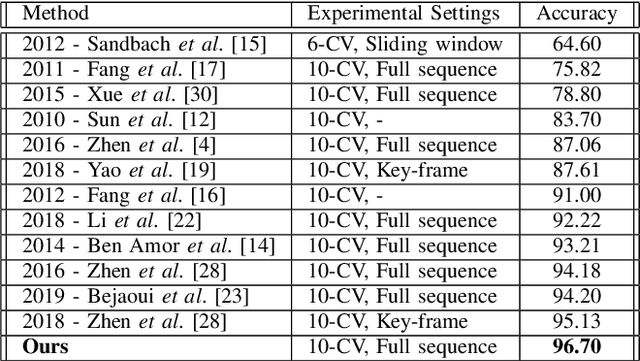
Abstract:We propose a novel landmarks-assisted collaborative end-to-end deep framework for automatic 4D FER. Using 4D face scan data, we calculate its various geometrical images, and afterwards use rank pooling to generate their dynamic images encapsulating important facial muscle movements over time. As well, the given 3D landmarks are projected on a 2D plane as binary images and convolutional layers are used to extract sequences of feature vectors for every landmark video. During the training stage, the dynamic images are used to train an end-to-end deep network, while the feature vectors of landmark images are used train a long short-term memory (LSTM) network. The finally improved set of expression predictions are obtained when the dynamic and landmark images collaborate over multi-views using the proposed deep framework. Performance results obtained from extensive experimentation on the widely-adopted BU-4DFE database under globally used settings prove that our proposed collaborative framework outperforms the state-of-the-art 4D FER methods and reach a promising classification accuracy of 96.7% demonstrating its effectiveness.
Automatic 4D Facial Expression Recognition via Collaborative Cross-domain Dynamic Image Network
May 07, 2019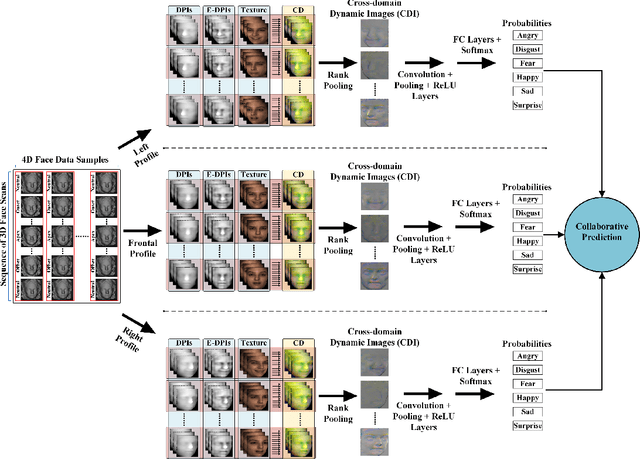
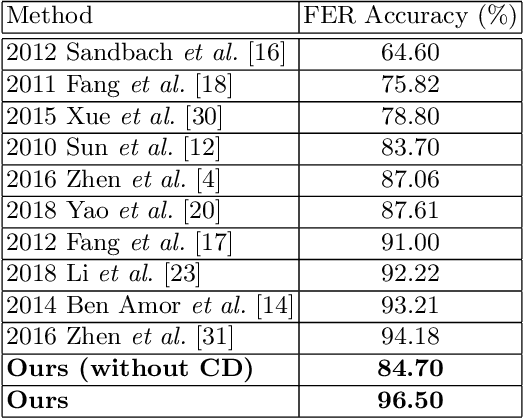
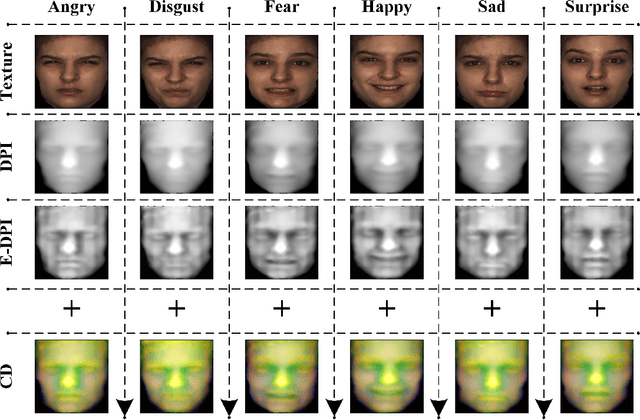

Abstract:This paper proposes a novel 4D Facial Expression Recognition (FER) method using Collaborative Cross-domain Dynamic Image Network (CCDN). Given a 4D data of face scans, we first compute its geometrical images, and then combine their correlated information in the proposed cross-domain image representations. The acquired set is then used to generate cross-domain dynamic images (CDI) via rank pooling that encapsulates facial deformations over time in terms of a single image. For the training phase, these CDIs are fed into an end-to-end deep learning model, and the resultant predictions collaborate over multi-views for performance gain in expression classification. Furthermore, we propose a 4D augmentation scheme that not only expands the training data scale but also introduces significant facial muscle movement patterns to improve the FER performance. Results from extensive experiments on the commonly used BU-4DFE dataset under widely adopted settings show that our proposed method outperforms the state-of-the-art 4D FER methods by achieving an accuracy of 96.5% indicating its effectiveness.
 Add to Chrome
Add to Chrome Add to Firefox
Add to Firefox Add to Edge
Add to Edge